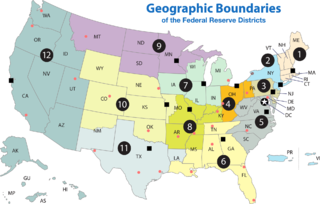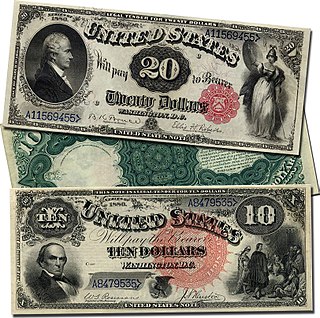
The Federal Reserve System is the central banking system of the United States. It was created on December 23, 1913, with the enactment of the Federal Reserve Act, after a series of financial panics led to the desire for central control of the monetary system in order to alleviate financial crises. Over the years, events such as the Great Depression in the 1930s and the Great Recession during the 2000s have led to the expansion of the roles and responsibilities of the Federal Reserve System.

The Second Bank of the United States was the second federally authorized Hamiltonian national bank in the United States. Located in Philadelphia, Pennsylvania, the bank was chartered from February 1816 to January 1836. The bank's formal name, according to section 9 of its charter as passed by Congress, was "The President, Directors, and Company, of the Bank of the United States". While other banks in the US were chartered by and only allowed to have branches in a single state, it was authorized to have branches in multiple states and lend money to the US government.

The National Banking Acts of 1863 and 1864 were two United States federal banking acts that established a system of national banks, and created the United States National Banking System. They encouraged development of a national currency backed by bank holdings of U.S. Treasury securities and established the Office of the Comptroller of the Currency as part of the United States Department of the Treasury and a system of nationally chartered banks. The Act shaped today's national banking system and its support of a uniform U.S. banking policy.
The Specie Payment Resumption Act of January 14, 1875 was a law in the United States that restored the nation to the gold standard through the redemption of previously unbacked United States Notes and reversed inflationary government policies promoted directly after the American Civil War. The decision further contracted the nation's money supply and was seen by critics as an exacerbating factor of the so-called Long Depression, which struck in 1873.

The Aldrich–Vreeland Act was a United States law passed in response to the Panic of 1907 which established the National Monetary Commission.

The Federal Reserve Act was passed by the 63rd United States Congress and signed into law by President Woodrow Wilson on December 23, 1913. The law created the Federal Reserve System, the central banking system of the United States.

A Federal Reserve Bank is a regional bank of the Federal Reserve System, the central banking system of the United States. There are twelve in total, one for each of the twelve Federal Reserve Districts that were created by the Federal Reserve Act of 1913. The banks are jointly responsible for implementing the monetary policy set forth by the Federal Open Market Committee, and are divided as follows:

A United States Note, also known as a Legal Tender Note, is a type of paper money that was issued from 1862 to 1971 in the United States. Having been current for 109 years, they were issued for longer than any other form of U.S. paper money. They were known popularly as "greenbacks", a name inherited from the earlier greenbacks, the Demand Notes, that they replaced in 1862. Often termed Legal Tender Notes, they were named United States Notes by the First Legal Tender Act, which authorized them as a form of fiat currency. During the early 1860s the so-called second obligation on the reverse of the notes stated:
This Note is a Legal Tender for all debts public and private except Duties on Imports and Interest on the Public Debt; and is receivable in payment of all loans made to the United States.

The Panic of 1837 was a financial crisis in the United States that began a major depression, which lasted until the mid-1840s. Profits, prices, and wages dropped, westward expansion was stalled, unemployment rose, and pessimism abounded.
The Panic of 1819 was the first widespread and durable financial crisis in the United States that slowed westward expansion in the Cotton Belt and was followed by a general collapse of the American economy that persisted through 1821. The Panic heralded the transition of the nation from its colonial commercial status with Europe toward an independent economy.
This history of central banking in the United States encompasses various bank regulations, from early wildcat banking practices through the present Federal Reserve System.

Wildcat banking was the issuance of paper currency in the United States by poorly capitalized state-chartered banks. These wildcat banks existed alongside more stable state banks during the Free Banking Era from 1836 to 1865, when the country had no national banking system. States granted banking charters readily and applied regulations ineffectively, if at all. Bank closures and outright scams regularly occurred, leaving people with worthless money.

National Bank Notes were United States currency banknotes issued by National Banks chartered by the United States Government. The notes were usually backed by United States bonds the bank deposited with the United States Treasury. In addition, banks were required to maintain a redemption fund amounting to five percent of any outstanding note balance, in gold or "lawful money." The notes were not legal tender in general, but were satisfactory for nearly all payments to and by the federal government.

The Bank War was a political struggle that developed over the issue of rechartering the Second Bank of the United States (B.U.S.) during the presidency of Andrew Jackson (1829–1837). The affair resulted in the shutdown of the Bank and its replacement by state banks.

Suffolk Bank was a private clearinghouse bank in Boston, Massachusetts, that exchanged specie or locally backed bank notes for notes from country banks to which city-dwellers could not easily travel to redeem notes. The bank was issued its corporate charter on February 10, 1818 by the 38th Massachusetts General Court to a group of the Boston Associates, and the charter's holders and bank's directors met periodically from February 27 to March 19 at the Boston Exchange Coffee House to discuss the organization of the bank. On April 1, 1818, the bank opened for business in rented offices on State Street until the bank moved permanently to the corner of State and Kilby Streets on April 17. In addition to Jackson and Parker, other prominent shareholders of the bank included William Appleton, Nathan Appleton, Timothy Bigelow, John Brooks, Gardiner Greene, Henry Hubbard, Augustine Heard, Amos Lawrence, Abbott Lawrence, Luther Lawrence, William Prescott, Dudley Leavitt Pickman, and Benjamin Seaver.

The presidency of Martin Van Buren began on March 4, 1837, when Martin Van Buren was inaugurated as President of the United States, and ended on March 4, 1841. Van Buren, the incumbent vice president and chosen successor of President Andrew Jackson, took office as the eighth United States president after defeating multiple Whig Party candidates in the 1836 presidential election. A member of the Democratic Party, Van Buren's presidency ended following his defeat by Whig candidate William Henry Harrison in the 1840 presidential election.

A Treasury Note is a type of short term debt instrument issued by the United States prior to the creation of the Federal Reserve System in 1913. Without the alternatives offered by a federal paper money or a central bank, the U.S. government relied on these instruments for funding during periods of financial stress such as the War of 1812, the Panic of 1837, and the American Civil War. While the Treasury Notes, as issued, were neither legal tender nor representative money, some issues were used as money in lieu of an official federal paper money. However the motivation behind their issuance was always funding federal expenditures rather than the provision of a circulating medium. These notes typically were hand-signed, of large denomination, of large dimension, bore interest, were payable to the order of the owner, and matured in no more than three years – though some issues lacked one or more of these properties. Often they were receivable at face value by the government in payment of taxes and for purchases of publicly owned land, and thus "might to some extent be regarded as paper money." On many issues the interest rate was chosen to make interest calculations particularly easy, paying either 1, 1+1⁄2, or 2 cents per day on a $100 note.
This article details the history of banking in the United States. Banking in the United States is regulated by both the federal and state governments.
Monetary policy in the United States is associated with interest rates and availability of credit.
William M. Gouge was an American economist who published A Short History of Paper Money and Banking in the United States, an 1833 treatise that advocated for hard money policies. Following the publication of his treatise, Gouge emerged as an important figure in the presidential administrations of Andrew Jackson and Martin Van Buren, and he played a major role in the creation of the Independent Treasury system. Historian Sean Wilentz writes that, "if anyone was the intellectual architect of Jacksonian economic policy after 1832, it was the Philadelphia radical William Gouge".













